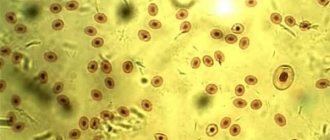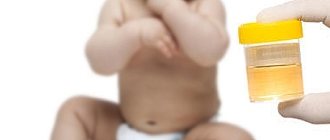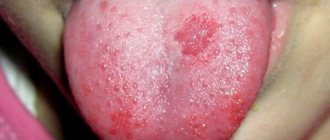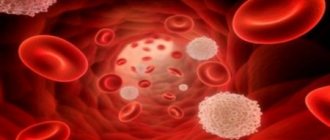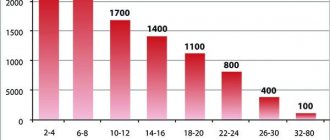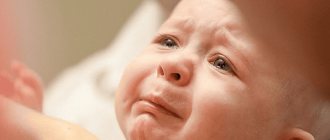How are they detected in urine?
Why does a one-year-old child have no teeth - timing of appearance
If there are no symptoms indicating that the urinary system is affected, then oxalic acid salts in the urine can be detected during a general urinalysis (UCA). General urinalysis is a comprehensive study of the physical and chemical properties of urine, which also includes microscopic examination of sediment. Oxalates in a baby's urine are often detected during urine microscopy.
Note! The composition of the urine depends on whether the material for the study was collected correctly. It is worth listening to Komarovsky’s advice and not using empty food or medicine jars for collection. You only need to collect urine for analysis in special containers that can be purchased at the pharmacy.
Komarovsky on urine results in children
Dr. Komarovsky, in his characteristic manner, shared his opinion on the results of a clinical urine test in a child. According to everyone’s favorite pediatrician, there can be only two problems:
- Get this very urine from the child.
- Understand the conclusion.
How to properly collect material for analysis will be described in the next paragraph of our article. And now about the results of the child’s urine.
When parents receive a scribbled piece of paper with different numbers, numbers of pluses and incomprehensible medical abbreviations in their hands, they are scared half to death. But such premature frustration is completely unfounded. To understand children's tests yourself, you need to know a couple of secrets.
The presence of leukocytes in the “field of view”. What kind of “field of view” is this? The answer is simple - this is the number of leukocytes that the laboratory technician sees when examining the sedimented analysis under a microscope.
If there are 1-2 leukocytes in the field of view, then this is considered normal. If the conclusion indicates more of these cells, for example, 20-30 per field of view, this indicates the development of a urethral infection. And it happens that leukocytes block the entire field of view. The laboratory assistant will write down the white blood cells in the entire field of view on the form.
The presence of 1-2 leukocytes in the field of view is considered normal
Red blood cells in urine are a sign of microtrauma of the urinary tract or kidney disease. Sugar in the urine indicates the development of diabetes, acetone indicates a violation of carbohydrate metabolism, glucose deficiency. The presence of oxalates in a child’s urine is associated with eating foods rich in oxalic acid (oranges, apples, beets, tomatoes) rather than with an overt disease.
The norm of oxalates in the urine of an infant
Vomiting water in a child under 1 year of age - what to do when he feels sick
As with any indicators, there are certain standards for oxalate in urine; they directly depend on the age of the child:
- For a baby up to one year old, the norm is 1-1.3 mg/kg per day;
- For children under 3 years old, a little - 0.5 mg/kg per day.
Additional Information. Elevated oxalates in a baby’s urine can be detected after a nursing mother ate salty or spicy food the day before. This will mean that the pediatrician must order a repeat test and advise the mother about her diet before taking it. If after the second analysis the diagnosis is confirmed, the doctor must prescribe treatment for the small patient.
Oxalates in the urine appear not only due to an ongoing disease in the body, they can also be detected for other reasons. When collecting urine for research, you need to carefully prepare for the test for the presence of oxalates. To do this you should:
- Collect all daily urine in only one, absolutely sterile container;
- There is no need to collect the first morning portion of urine; start collecting only from the second urination;
- The last portion of urine should be collected the next morning;
- Next, you need to mix all the daily urine in one container, take 100 ml and pour it into a special container for testing;
- Take the container with urine to the laboratory and write on it the total amount of urine per day.
What is the normal level of oxalates in the urine and are there any symptoms indicating its increase?
From birth until the age of 14, a child’s normal level of calcium oxalate in urine is 8.0 – 17.0 mg. From 14 years of age, the maximum amount of salt in urine that is normal is 40.0 mg.
If the permissible norm is exceeded, the child will have one or several symptoms:
- Rare urination, unpleasant strong odor of urine;
- Urine has a dark yellow tint. Sometimes urine may be brown in color;
- Increased fatigue;
- Headaches that appear without the presence of provoking factors;
- Restless sleep.
Unfortunately, these symptoms are rarely associated with the possibility of increased salt in the urine. Most often, when a child complains, adults eliminate these symptoms with local medications, without even trying to find out the root cause of their occurrence. Therefore, a urine test is taken to check for the presence of calcium salts even if the child has severe symptoms such as pain in the groin area and lower back. If the disease develops in an infant, then when it is neglected, the baby often begins to cry restlessly.
It’s worth knowing that excess oxalate levels can occur at literally any age. But most often calcium in the urine is found in children over 6 years of age.
If symptoms appear that may indicate calcium in the urine, the doctor will prescribe an appropriate test. If the analysis confirms the presence of excess oxalate in the urine, then the child will not only have to undergo complex treatment, but also switch to a special diet. Calcium present in urine can provoke the development of pyelonephritis or urolithiasis in a child. Therefore, treatment and application of the required diet should begin as early as possible.
Reasons for the appearance of oxalate salts
In breastfed babies, oxalates in the urine most often appear due to improper nutrition of the nursing mother, but this may also indicate a pathology of metabolic processes in the baby’s body. In addition, excess oxalic acid salts in the urine can occur due to congenital kidney disease.
Constipation in a 7-11 month old baby - causes and types
Oxalaturia is divided into two types:
- Primary;
- Secondary.
Primary – considered congenital, it occurs due to a hereditary disorder of oxalic acid metabolism in the body. Secondary - appears due to the development of certain diseases or the consumption of certain foods.
The non-pathological cause of oxalaturia is the consumption of foods rich in oxalic acid by a nursing mother. These include tea, spinach, rhubarb, beets, and chocolate.
Important! A nursing mother should know that all the nutrients and toxic substances from the foods she eats get into her milk.
Also, reasons for the appearance of more than moderate amounts of oxalates in the urine of a child include:
- Congenital disorders in metabolic processes in which oxalic acid takes part. As a result, its removal from the body is disrupted;
- Inflammation of the kidneys or intestines;
- Diabetes;
- Stones in the kidneys;
- Various chronic pathologies;
- Lack of B vitamins;
- Dysmetabolic nephropathy. It appears due to hereditary predisposition or certain mutations in the baby's genes;
- Dehydration, which is caused by prolonged exposure to the hot sun, intestinal infection, fever with increased sweating and insufficient drinking regimen for infants.
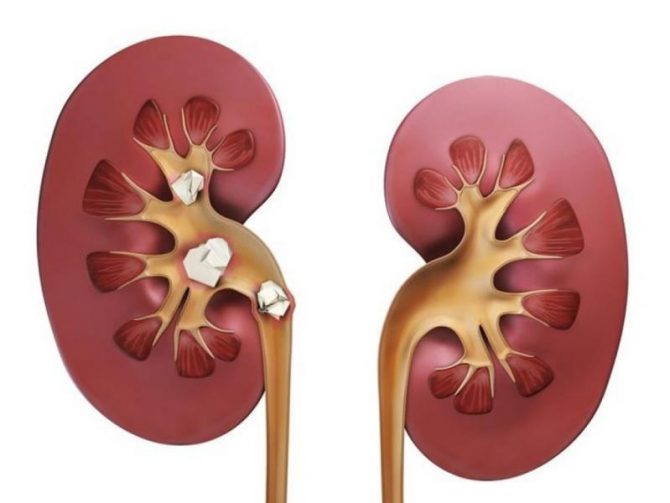
Oxalaturia
Causes of oxalaturia in a child
An increased concentration of salt crystals in the urine can occur without disrupting the mechanisms of metabolism and excretion of metabolic products against the background of:
- climate features, to which is added improper drinking regime;
- abnormally high sweating;
- intoxication;
- states of dehydration;
- stress, shock;
- intake of vitamin C in excess quantities and/or deficiency of B vitamins;
- consuming large quantities of a number of foods or water with a high proportion of dissolved mineral salts - this also applies to the mother’s nutrition, if we are talking about an infant.
In these cases, oxalate crystalluria in children is functional in nature and disappears when the cause is eliminated. It is important to differentiate it from pathological oxalaturia, the source of which is primary or secondary disorders.
The congenital prerequisites for excess excreted salts are a defect in the enzyme system, leading to an increase in the concentration of oxalic acid in urine. Primary oxalaturia is detected in boys under 5 years of age and is accompanied by developmental defects, defects of the skeletal system, and manifestations of osteoporosis. Fortunately, such a situation, the only way out of which is an organ transplant, rarely arises in pediatric practice.
Secondary oxalaturia most often occurs in children over 6 years of age due to metabolic or renal disorders, such as:
- diabetes;
- nephrotic syndrome;
- dismetabolic nephropathy;
- inflammatory bowel diseases and dysbiosis;
- disturbances in the functioning of the liver and pancreas;
- kidney diseases, including pyelonephritis and glomerulonephritis;
- malfunction of the renal tubules;
- disturbance of the outflow of urine and motility of the urinary tract;
- changes in the functioning of the parathyroid glands;
- traumatic kidney damage.
Sometimes nephrolithiasis, urolithiasis, is also mentioned as a cause, although it would be more correct to call it a consequence of oxalaturia.
Symptoms of oxalaturia in children
Parents should pay special attention to the baby’s health in this case:
- The baby's urine has acquired a sharp, unpleasant odor;
- The color of urine changed from light yellow to dark yellow for no reason;
- The baby has a very frequent urge to urinate, while the total amount of urine has noticeably decreased;
- The baby often cries because he is bothered by a sharp pain in the lower back or lower abdomen, which may indicate renal colic;
- The child's general condition worsened, apathy developed, sleep was disturbed, and his appetite disappeared.
Note! If even some of the above symptoms occur, parents should consult a pediatrician as soon as possible and ask for a referral for a general urine test. If the diagnosis of oxalaturia is confirmed, appropriate measures should be taken immediately and treatment should begin.
Possible complications
Untimely or lack of any treatment can lead to the accumulation of salts in a small body, this will provoke serious complications. The child's oxalates will gradually accumulate in the kidneys and begin to form crystals, sand and stones. The resulting stones lead to blockage of the urinary canals, this will be accompanied by very severe and sharp pain.
The sharp edges of the crystals will injure tissue and lead to bleeding, pyelonephritis, disruption of the proper functioning of the kidneys and other diseases that cause inflammation of internal organs and tissues. Without appropriate treatment, the baby may experience kidney failure, metabolic disorders, and blockage of the urinary system.
Causes of pathology
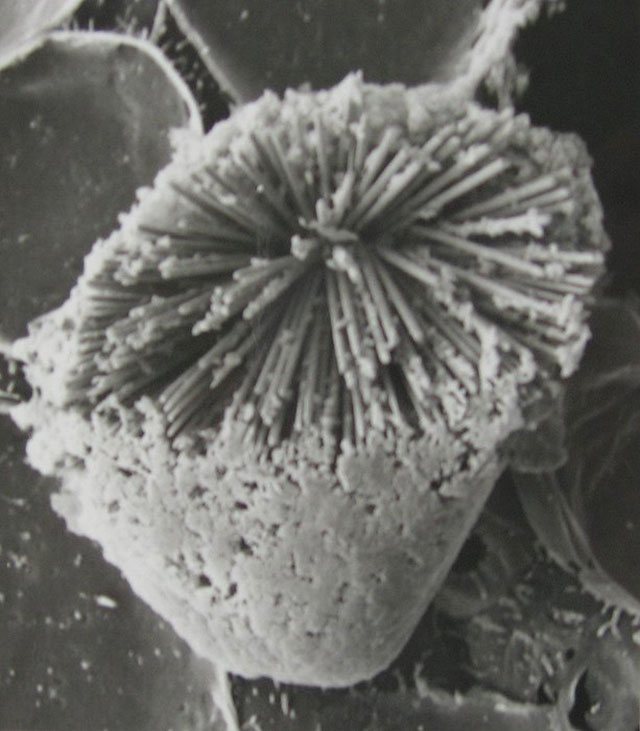
In fact, the appearance of oxalates in the urine is a consequence of an overproduction of oxalic acid and its compounds in the body.
Reasons for the appearance of oxalates in the urine of a child:
- violation of the rules of nutrition and drinking regime, excess of foods rich in oxalic acid in the diet of children;
- nephrotic syndrome - disruption of the urinary system and salt retention in the body;
- metabolic nephropathy is a disruption of the processes of absorption and processing of oxalic acid in the body. Most often occurs in adolescents aged 10 to 14 years;
- expansion of the renal pelvis - this disrupts the normal outflow of urine, and the kidneys do not excrete fluid in sufficient volume.
Prevention, features of the breastfeeding diet
Elevated levels of oxalates can be detected regardless of age. Very often they are found in the analysis of a breastfed child. Oxaluria is very closely related to the diet of a nursing mother, because all the foods she consumes enter the baby’s body with breast milk. Also, excessive formation of oxalates can occur due to pathological processes in the kidneys, congenital metabolic disorders, and unfavorable hereditary factors.
There are very few nursing mothers who follow a certain diet during the breastfeeding period. Their food is familiar, without restrictions in anything, they do not follow any diet. As a result, the baby's oxalate levels may rise above normal.
If the baby is breastfed, the nursing mother must adhere to a proper and balanced diet so as not to harm her baby’s body.
If oxalates are detected in a child, the mother should exclude sources of oxalic acid from her diet:
- Rhubarb;
- Sorrel;
- Spinach;
- Beetroot;
- Products containing cocoa;
- Parsley;
- Onion;
- Radish; rutabaga;
- Citrus;
- Sour berries;
- Plums;
- Almond;
- Green beans.
In addition, you should give up sour fruits, tomatoes, liver, coffee, and strong tea. It is equally important to reduce your salt intake. If the disease progresses significantly, you need to limit your diet to foods that contain large quantities of calcium: dairy products, greens, legumes, cereals, flour products. The minimum period for following the diet is two weeks.
The mother’s diet must contain foods that contain vitamins A and B, magnesium, potassium, and protein. It is very important to eat grapes, quince, cabbage and potatoes, bananas, cucumbers and pumpkin, dried fruits, pears and apricots, vegetable oils and meat.
Important! Parents must organize a proper sleep and rest schedule for the child, which includes sufficient activity and walks in the fresh air. The children's room should be kept cool and moderately damp. Regarding the environment, it is important to provide the child with psychological comfort.
Oxalates are detected very often in urine tests in infants. Parents don't need to worry right away. This happens when the baby’s mother violates the diet or collects urine incorrectly for analysis. If the diagnosis is confirmed again, it is important to follow all the doctor’s recommendations: follow a proper diet and take medications.
Why does the concentration of oxalates increase in a child’s urine?
Have you been trying to cure your KIDNEYS for many years?
Head of the Institute of Nephrology: “You will be amazed at how easy it is to heal your kidneys just by taking it every day...
Read more "
While the child is small, parents should monitor his health. Urinalysis is an indicator of the proper functioning of the body, allowing you to quickly identify violations. But oxalates are often found in a child’s urine. Such substances are present in the body of every person, but in small quantities, and they are not dangerous. And exceeding the norm is already a problem that needs to be treated.
General characteristics of the condition
The formation of calcium oxalate in the body is pathologically enhanced against the background of oxalic acid metabolic disorders. It is important to observe how often the concentration of this compound increases. If the analysis once revealed oxalate crystals, then there is no need to worry. Most likely, shortly before the test, the child ate food rich in oxalic acid. To confirm the diagnosis, the doctor prescribes a repeat test - it will confirm or refute kidney dysfunction.
If oxalates are detected in the child’s urine during a second test, you cannot do without consulting a specialist. If necessary, you will have to undergo additional examinations. Doctors recommend following a diet for two days before taking the test for oxalates and phosphates - this reduces the risk of getting an unreliable result.
The daily norm of oxalates in the urine of a child, depending on age, changes as follows:
- newborns and children under 3 years of age – 0.5 mg;
- children 3-5 years old – 12 mg;
- from 5 years and older – 20 mg.
Hormonal imbalance, stress and some other diseases can manifest as oxalaturia. Most often, children between the ages of 6 and 14 are at risk.
Main reasons
Salts of oxalic acid are formed during metabolic processes and only a small part of them comes from food. The normal content of oxalates in the urine for a 3-year-old child is 10-12 mg, but there are conditions in which the levels are elevated. The main reasons are:
- genetic (hereditary) diseases;
- chronic diseases of the digestive system;
- dysbacteriosis and insufficient content of lactobacilli in the intestines;
- liver and pancreas diseases;
- diabetes mellitus and associated disruptions in metabolic processes;
- abuse of B vitamins, for example, in the treatment of rickets;
- insufficient amount of vitamins (B6) or their excess;
- lack of enzymes;
- small amount of fluid consumed;
- consuming salt in excess of the norm;
- unbalanced diet.
Oxalates in newborns
Elevated oxalates are detected in urine regardless of age; sometimes they can be seen in the analysis of a breastfed baby. Oxaluria is closely related to the mother’s diet, because the foods she eats enter the baby’s body through breast milk. On the other hand, excessive formation of oxalates can occur due to kidney pathology, congenital metabolic disorders, or an unfavorable hereditary factor.
There are very few mothers who adhere to a certain correct diet during breastfeeding. Their diet is usual, without restrictions in anything, they neglect the diet. As a result, the child's oxalate concentration may rise above normal.
During the period of breastfeeding, the mother must adhere to a proper and balanced diet so as not to harm the baby’s body. During the lactation period, it is not recommended to drink coffee, strong tea, as well as some vegetables and fruits containing large amounts of oxalic acid.
Characteristic symptoms
Oxalaturia in children can occur at different ages; it is important to identify its symptoms in the early stages and begin to look for the causes. To identify the problem in a timely manner, you need to take a close look at the child and assess whether he has any alarming symptoms. The child experiences a frequent urge to urinate - this is the first sign of ill health. At the same time, the amount of urine is different: the daily norm sometimes decreases, sometimes increases. This condition should alert parents. In addition, the child’s urine has a rich color.
Children complain of abdominal pain. It can be either short-term or long-term. Increased weakness, fatigue, and headaches are likely. Children sleep poorly and are constantly capricious; infants often refuse to breastfeed.
A doctor can make an accurate diagnosis. Causes for concern arise when the oxalate level exceeds 50 mg. The analysis also often shows increased levels of protein, white blood cells and red blood cells.
Treatment
To get rid of the disease, you must adhere to a certain diet and drink enough fluid. The oxalate diet is not particularly strict, so it is suitable for everyday use and should become a habit over time. Children grow and develop quickly, and parents need to pay special attention to their diet to maintain health.
The following fruits remove acid from the body: pears, quince, sweet apples. They can be eaten raw, baked, boiled, made into fruit purees, or cooked into compotes. With intensive release of oxalic acid from the body, it is necessary to restore the mineral balance, so taking dried apricots and prunes is indicated.
The child must drink enough liquid. The daily norm is 2 liters. It is not necessary to exhaust your baby with drinking - it must be evenly distributed between meals.
The following drinks are ideal for oxalaturia:
- fruit decoctions, decoctions of dried fruits, compotes;
- vegetable and fruit juices, which must be prepared immediately before consumption;
- rowan and birch juice;
- decoctions and infusions of medicinal herbs (knotweed, half-palm, corn silk, dill seeds, horsetail);
- bottled water designed specifically for children;
- boiled or filtered water.
There is a list of foods that should be included in the diet in limited quantities. You shouldn't completely abandon them. It is important to dose such food and monitor it carefully:
- salt should be consumed no more than 2 grams per day;
- eat less carbohydrate-containing foods;
- honey and sugar should be consumed no more than one tablespoon per day.
Dietary nutrition is a prerequisite for treatment. It is forbidden to eat greens, plums, and strawberries. Products with a high content of vitamin C should be completely excluded. The diet should include low-fat poultry, liver, onions, and potatoes.
The menu for one day looks something like this. Breakfast - milk oatmeal with butter and prunes, berry juice or yogurt. For lunch, cereal soup with chicken, white bread, compote. You can have an afternoon snack with fruit, and for dinner give your child boiled potatoes with a steam cutlet and fruit jelly.
Possible complications
Untimely or complete lack of treatment leads to the accumulation of salts in the body, which is fraught with serious complications:
- urolithiasis disease;
- pyelonephritis;
- renal failure;
- metabolic disease.
Oxalates in the urine of infants gradually accumulate in the kidneys and form crystals, sand and stones. The formation of stones leads to blockage of the urinary canals, this process is accompanied by severe pain. The sharp edges of the stones injure tissues and lead to bleeding, disrupting kidney function until they stop working.
The folk way to cleanse the kidneys! Our grandmothers were treated using this recipe...
Cleaning your kidneys is easy! You need to add it during meals...
Preventive measures
Prevention of oxalates in urine involves preventing their formation. To do this, you must adhere to the following rules:
- it is necessary to consume a sufficient amount of fluid per day;
- avoid hypothermia;
- Moderate physical activity is important;
- a balanced diet and regular meals, excluding foods high in oxalic acid;
- good dream;
- sufficient exposure to fresh air.
The presence of oxalates in a child’s urine is a serious problem that requires an immediate visit to the doctor. Ignoring it leads to the development of serious diseases. Children who have elevated oxalates need to improve their drinking regime. In this condition, this is the basis of health.
